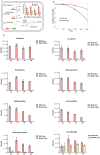Genome-wide transcriptome and antioxidant analyses on gamma-irradiated phases of deinococcus radiodurans R1
- PMID: 24465634
- PMCID: PMC3900439
- DOI: 10.1371/journal.pone.0085649
Genome-wide transcriptome and antioxidant analyses on gamma-irradiated phases of deinococcus radiodurans R1
Abstract
Adaptation of D. radiodurans cells to extreme irradiation environments requires dynamic interactions between gene expression and metabolic regulatory networks, but studies typically address only a single layer of regulation during the recovery period after irradiation. Dynamic transcriptome analysis of D. radiodurans cells using strand-specific RNA sequencing (ssRNA-seq), combined with LC-MS based metabolite analysis, allowed an estimate of the immediate expression pattern of genes and antioxidants in response to irradiation. Transcriptome dynamics were examined in cells by ssRNA-seq covering its predicted genes. Of the 144 non-coding RNAs that were annotated, 49 of these were transfer RNAs and 95 were putative novel antisense RNAs. Genes differentially expressed during irradiation and recovery included those involved in DNA repair, degradation of damaged proteins and tricarboxylic acid (TCA) cycle metabolism. The knockout mutant crtB (phytoene synthase gene) was unable to produce carotenoids, and exhibited a decreased survival rate after irradiation, suggesting a role for these pigments in radiation resistance. Network components identified in this study, including repair and metabolic genes and antioxidants, provided new insights into the complex mechanism of radiation resistance in D. radiodurans.
Conflict of interest statement
Figures







Similar articles
-
Gene regulation for the extreme resistance to ionizing radiation of Deinococcus radiodurans.Gene. 2019 Oct 5;715:144008. doi: 10.1016/j.gene.2019.144008. Epub 2019 Jul 27. Gene. 2019. PMID: 31362038 Review.
-
A Genome-Wide Search for Ionizing-Radiation-Responsive Elements in Deinococcus radiodurans Reveals a Regulatory Role for the DNA Gyrase Subunit A Gene's 5' Untranslated Region in the Radiation and Desiccation Response.Appl Environ Microbiol. 2017 May 31;83(12):e00039-17. doi: 10.1128/AEM.00039-17. Print 2017 Jun 15. Appl Environ Microbiol. 2017. PMID: 28411225 Free PMC article.
-
iTRAQ-based proteomic analysis of Deinococcus radiodurans in response to 12C6+ heavy ion irradiation.BMC Microbiol. 2022 Nov 4;22(1):264. doi: 10.1186/s12866-022-02676-x. BMC Microbiol. 2022. PMID: 36333788 Free PMC article.
-
Transcriptome dynamics of Deinococcus radiodurans recovering from ionizing radiation.Proc Natl Acad Sci U S A. 2003 Apr 1;100(7):4191-6. doi: 10.1073/pnas.0630387100. Epub 2003 Mar 21. Proc Natl Acad Sci U S A. 2003. PMID: 12651953 Free PMC article.
-
Mechanisms of Stress Resistance and Gene Regulation in the Radioresistant Bacterium Deinococcus radiodurans.Biochemistry (Mosc). 2015 Oct;80(10):1201-16. doi: 10.1134/S0006297915100016. Biochemistry (Mosc). 2015. PMID: 26567564 Review.
Cited by
-
Untargeted metabolite profiling reveals that nitric oxide bioynthesis is an endogenous modulator of carotenoid biosynthesis in Deinococcus radiodurans and is required for extreme ionizing radiation resistance.Arch Biochem Biophys. 2016 Jan 1;589:38-52. doi: 10.1016/j.abb.2015.10.010. Epub 2015 Nov 10. Arch Biochem Biophys. 2016. PMID: 26550929 Free PMC article.
-
Proteometabolomic response of Deinococcus radiodurans exposed to UVC and vacuum conditions: Initial studies prior to the Tanpopo space mission.PLoS One. 2017 Dec 15;12(12):e0189381. doi: 10.1371/journal.pone.0189381. eCollection 2017. PLoS One. 2017. PMID: 29244852 Free PMC article.
-
Carotenoids from UV-resistant Antarctic Microbacterium sp. LEMMJ01.Sci Rep. 2019 Jul 2;9(1):9554. doi: 10.1038/s41598-019-45840-6. Sci Rep. 2019. PMID: 31266976 Free PMC article.
-
Oxidative stress response of Deinococcus geothermalis via a cystine importer.J Microbiol. 2017 Feb;55(2):137-146. doi: 10.1007/s12275-017-6382-y. Epub 2017 Jan 26. J Microbiol. 2017. PMID: 28120190
-
Temporal Gene Expression of the Cyanobacterium Arthrospira in Response to Gamma Rays.PLoS One. 2015 Aug 26;10(8):e0135565. doi: 10.1371/journal.pone.0135565. eCollection 2015. PLoS One. 2015. PMID: 26308624 Free PMC article.
References
-
- Hagen U (1994) Mechanisms of induction and repair of DNA double-strand breaks by ionizing radiation: some contradictions. Radiat Environ Biophys 33: 45–61. - PubMed
-
- Daly MJ, Gaidamakova E, Matrosova V, Vasilenko A, Zhai M, et al. (2004) Accumulation of Mn (II) in Deinococcus radiodurans facilitates gamma-radiation resistance. Science 306: 1025–1028. - PubMed
-
- Cox MM, Battista JR (2005) Deinococcus radiodurans - the consummate survivor. Nat Rev Microbiol 3: 882–892. - PubMed
-
- Pocker Y, Li H (1991) Kinetics and mechanism of methanol and formaldehyde interconversion and formaldehyde oxidation catalyzed by liver alcohol dehydrogenase. Adv Exp Med Biol 284: 315–325. - PubMed
Publication types
MeSH terms
Substances
LinkOut - more resources
Full Text Sources
Other Literature Sources
Medical

